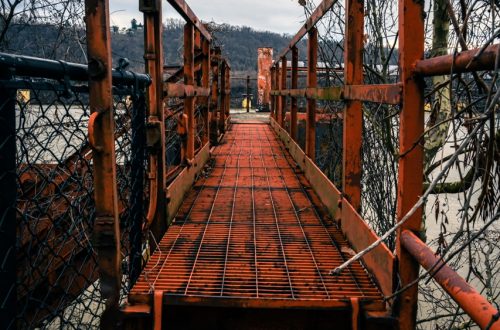KAP in Michigan on Vacation
Jenny and I arrived back from vacation in Michigan’s Upper Peninsula this past Sunday afternoon. We had a great time. I’ll have to write more on that later. While there, I finally had the chance to get my kite aerial photography (KAP) rig into the air, and it actually got some pictures!
I have some moderate woodworking skills, and a tiny bit of skill with metal, so I decided to build my own rig. I also have experience with electronics and microprocessors, so I also decided that I’d build my own controller for it. My initial idea was to construct something like the “AutoKAP” rig that is available commercially, with the intention that I would eventually add some additional ground control features.
I had some 1/8″ thick aluminum bar stock that I had purchased for another project, so that became the Picavet suspension (a type of corded suspension system that allows the camera to hang level from the kite line, even if the line changes orientation during flight (which it does often)) and a vertically-oriented camera mount. I went with the vertical orientation to make a few things simpler, including adjustment of tilt angle and rig balance. I built the Picavet with elements about 6″ long, which turned out to be a good measurement. I strung the mount with about 30 feet of 100lb. line, using solid rings for the top mounts and standard eye bolts for the bottom mounts. It took me two tries to get it strung correctly, but hey–it worked. 
The camera used was an older Olympus 460D digicam, which I had opened and modified for remote shutter release via a pair of wires that, when shorted, acted as a depressed shutter button.
I built a small electronics unit, utilizing an Atmel ATMega168 microprocessor as its core, and two transistor-switched circuits driven from that chip. One circuit was for shutter release, and the other to activate the panning motor. I didn’t have a servo handy, but I did have a small DC motor, so that’s what I used for pan. I figured that I could turn it on for a set amount of time, then take another picture. It wouldn’t be as accurate as a servo, but I should still be able to get good coverage. I was trying to save some money on this, so I was only using parts that I had available.
The electronics unit was powered by a standard 9VDC battery, running through a 5VDC regulator circuit to provide clean power to the microprocessor. I had originally planned on using a dual-9V setup, but I didn’t have a variable regulator in my bag of extra parts, so I had to power the motor with a separate pair of AA batteries (it was rated for operation at 1.5-3VDC).
Initial tests showed that the electronics unit was working, the ~900ms time to press the shutter button seemed to be the right number to use, and everything seemed to be good to go. I added a 60-second delay after start-up to avoid having bunches of pictures of my hands and the ground from five feet up. The pan motor was a little weak and didn’t always give a good pan, but it kind-of worked. I was planning to eventually do this with a servo anyway, so that’ll give me a good reason to do it early. 
Vacation on the shores of Lake Huron gave me a chance to try the rig for the first time. I got the kite into steady winds at the shore, then attached the rig about 20 feet from the kite. I let it into the air, and the camera was airborne! Woo hoo! I activated the camera and electronics, then let out about 300-350 feet of line. After about ten minutes in the air, I brought it down–I had my first pictures!
This first set of pictures showed some weaknesses of the crappy pan system, and the strength of the wind on the rig itself, sometimes turning the rig even when the panning motor wouldn’t do it.
Click on the thumbnail here to see some of those pictures:
After a few modifications, I decided to send it up again a few days later, on a different beach. I got the kite into some good winds just a scant ten feet or so off of the ground, so I let out a little bit of line before I attached the rig. The wind was good and strong, so I activated the camera, then walked back to my tie-down to let out a bunch of line. At about 100 feet of line or so, the kite caught a cross-breeze that was strong enough to turn it into a high-speed dive into the lake, dashing the rig against a bunch of rocks underwater at high speed. When the kite hit the water, it collapsed, leaving the whole mess in the lake. I walked-out to retrieve it, and wasn’t able to get the kite in the air again after that for more than a few seconds. Every time I got it up to about the same height, it would fly for a short while, then I’d feel the surface wind change, followed by the kite turning in the direction of the changed wind as it would plummet to the ground at high speed. The camera itself was toast, having been smashed against rocks at high speed, followed by a good soak in lake water. The electronics appeared to be okay, though, having suffered only a lost battery during the strike on the rocks (which probably saved the micro).
So, this was fun. I learned that I need to get my kite up to flying height, or close to it, then bring it down to attach the rig. That would have caused me to see the wind problem much earlier, and I probably wouldn’t have sent the KAP rig up the line. I need to get a new cheap digicam now, but I know this worked, and the pictures I have are awesome.
jonathan


